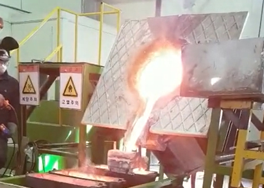What is the most efficient metal melting furnace?
The induction melting furnace is currently the most efficient and fastest induction heating equipment for heating metal materials.

The melting principle is:
using the principle of magnetic field induction eddy current heating, using current to pass through the coil to generate a magnetic field, through induction heating of the metal, the metal is instantly melted into liquid, purified, cast and other processes through the container.
Here are some types of metal melting furnaces that are considered to be efficient and their characteristics:
- Induction Furnace:
– Working principle: Using the principle of electromagnetic induction, an alternating magnetic field is generated through an induction coil to melt the metal in induction heating.
– High efficiency:
Electric energy is directly converted into heat energy, and the energy utilization rate is high.
– High temperature control accuracy:
The melting temperature can be accurately controlled.
– Environmental protection:
There is no combustion process, which reduces exhaust gas emissions.
– Rapid heating:
Induction heating is fast and the melting time is shortened.
- Electric Arc Furnace (EAF):
– Working principle: The metal is melted by generating high temperature through an electric arc, which is usually used in steel production.
– Advantages:
– High energy efficiency: Scrap steel can be used as raw material to reduce energy consumption.
– High temperature capability: It can reach extremely high temperatures and is suitable for melting various types of metals.
– Environmental protection: Compared with traditional blast furnaces, the exhaust gas and dust emissions are lower.
– Flexibility: production scale can be adjusted according to demand.
- Flash Smelting Furnace:
– Working Principle:
Powdered raw materials react quickly with oxygen at high temperature to melt metal.
– Advantages:
– High efficiency: the smelting process is fast and energy utilization is high.
– Environmental protection: less emissions and can process high sulfur content ores.
– Energy saving: use reaction heat for smelting to reduce external energy demand.
- Vacuum Melting Furnace:
– Working Principle: metal is melted by resistance heating or induction heating in a vacuum environment.
– Advantages:
– High purity: reduces oxidation and pollution, suitable for the production of high purity metals and alloys.
– Strong controllability: can accurately control temperature and atmosphere, suitable for the production of complex alloys.
– High energy efficiency: vacuum environment reduces heat loss.
- Solar Furnace:
– Working principle: Use concentrated solar beams to generate high temperatures to melt metals.
– Advantages:
– Green energy:
completely dependent on solar energy, zero carbon emissions.
– Low operating costs: almost no additional energy costs are required except for the initial investment.
– High temperature capability:
Able to reach extremely high melting temperatures.
These furnaces have their own advantages in different application scenarios. Which furnace to choose needs to be determined based on specific production needs, raw material types, environmental factors and cost considerations.
Induction furnaces are generally considered to be one of the most effective general-purpose metal melting furnaces currently available, especially in small-scale and high-precision melting.

